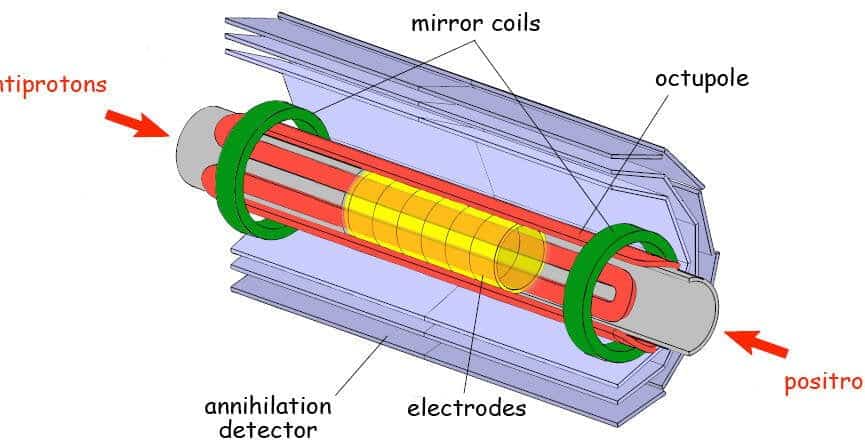The concept of antimatter annihilation is frequently discussed by science fiction authors as an incredibly potent and seemingly limitless energy source. After all, a minuscule quantity of antimatter is capable of producing a tremendously powerful explosion. In this article, we will explore what antimatter is and delve into the reasons why scientists have not yet harnessed this unparalleled energy resource.
Read “Hitech” in
What is antimatter?
The components of the cosmos – galaxies, stars, quasars, planets, supernovae, animals, and humans – consist of matter. Matter is composed of different elementary particles – quarks, leptons, bosons. However, it has been discovered that there exist particles in which one set of characteristics completely matches the parameters of the “originals,” while the other set has opposite values. This unique property led scientists to collectively term this group of particles as “antimatter.”
Based on the available data, it appears that there are currently no antigalaxies, antistars, or other large antimatter objects in existence. This is quite perplexing, considering that the Big Bang theory suggests that an equal amount of matter and antimatter were produced during the birth of our Universe. The question of where the antimatter has gone remains unanswered. There are currently two explanations for this phenomenon: either the antimatter vanished immediately following the explosion, or it exists in some distant corners of the universe that have yet to be discovered. This asymmetry stands as one of the most significant unresolved mysteries in the field of modern physics.
Antimatter is a unique form of matter made up of antiparticles, which are essentially “mirror images” of certain elementary particles. Despite having the same spin and mass as their corresponding particles, antiparticles differ in all other aspects of their interaction, including electric and color charge, baryonic and lepton quantum numbers. While some particles, like photons, do not have antiparticles and are essentially their own antiparticles.
According to current understanding, antiparticles react to the fundamental forces that shape the structure of matter, such as the strong interaction responsible for the formation of nuclei and the electromagnetic interaction that forms atoms and molecules. Therefore, the structure of antimatter is believed to be identical to that of “normal” matter.
What is the meaning of the prefix “anti”?
Typically, we use this prefix to indicate the opposite of a phenomenon. In the case of antimatter, it refers to counterparts of elementary particles that possess opposite charge, magnetic moment, and other characteristics. However, not all properties of a particle can be reversed. For instance, mass and lifetime must always remain positive. By focusing on these properties, we can classify particles into the same category, such as protons or neutrons.
When comparing a proton and an antiproton, some of their characteristics are identical, such as having a mass of 938.2719(98) megaelectronvolts and a spin of ½. However, the electric charge of a proton is +1, while an antiproton has a charge of -1. Similarly, their baryon numbers (which determine the number of strongly interacting particles composed of three quarks) are +1 and -1, respectively.
Pair birth is the process in which most antiparticles are generated alongside particles. This phenomenon necessitates a considerable amount of energy, specifically, immense speed. Antiparticles are naturally produced when cosmic rays interact with the Earth’s atmosphere, within massive stars, in the vicinity of pulsars, and near active galactic nuclei. Collider-accelerators are employed by scientists to replicate these occurrences.
What is the location for mining and storing antimatter?
The process of obtaining antimatter involves the extraction of clouds of antiprotons at the Large Hadron Collider. This is achieved through the collision of protons with a metal target, followed by a meticulous deceleration of the resulting particles for their utilization in future experiments.
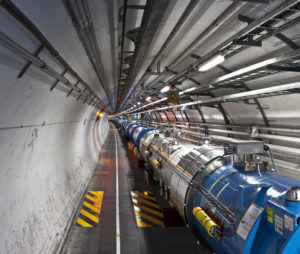

Positrons and antiprotons, which are charged particles of antimatter, can be stored in special devices called Penning traps. These traps function like miniature gas pedals for particles, allowing them to move in spirals while magnetic and electric fields prevent them from colliding with the trap walls.
However, Penning traps are not effective for neutral particles like antihydrogen, as these particles lack charge and cannot be confined by electric fields. Instead, neutral antimatter particles are trapped using Ioffe traps, which create a region of space where the magnetic field increases in all directions. Antimatter particles become trapped in the area with the weakest magnetic field.
The Earth’s magnetic field can also serve as a trap for antimatter. For example, antiprotons have been detected in certain regions around the Earth known as the Van Allen radiation belts.
What makes it challenging to acquire antimatter?
Obtaining antimatter has proven to be a formidable task, far more complicated than simply observing it. Antiparticles in a stable state have yet to be discovered in nature. The main obstacle lies in the fact that when matter and antimatter come into “contact,” they annihilate each other. Although it is possible to produce antimatter in labs, preserving it is a significant challenge. So far, scientists have only been able to maintain it for a few minutes.
Physicists face a significant challenge when it comes to storing antimatter. The problem arises from the fact that antiprotons and positrons annihilate upon contact with any ordinary matter particles. To overcome this obstacle, scientists have devised clever devices capable of preventing such catastrophes. One such device is the Penning trap, which resembles a miniature gas pedal. It utilizes a powerful magnetic and electric field to prevent the collision of positrons and antiprotons with the walls of the trap. However, this trap is not suitable for neutral objects like antihydrogen atoms. To address this issue, the Ioffe trap was developed. It relies on a magnetic field to retain antiatoms within its confines.
Antimatter, in small quantities, has the remarkable ability to generate a vast amount of energy, making it an attractive choice for fuel in science fiction depictions of futuristic vehicles. Theoretically, it is possible to power a rocket engine with antimatter; however, the main obstacle lies in the challenge of acquiring a sufficient quantity of antimatter.
Interestingly, just 1 milligram of antimatter possesses enough energy to propel a spacecraft to Mars.
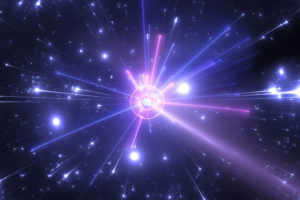
At present, there are no existing technologies capable of mass producing or gathering antimatter on the scale required for this particular application. Nevertheless, a limited number of researchers have dedicated their efforts to studying the modeling, motion, and storage of this elusive substance. Among these scientists are Ronan Keane from Western Reserve Academy, Wei-Ming Zhang from Kent State University, and Mark Weber and his colleagues from Washington State University. If, in the future, we manage to discover a method for generating or accumulating significant quantities of antimatter, the findings of these researchers could play a crucial role in turning antimatter-based interstellar travel into a tangible reality.
Why haven’t we harnessed this energy source yet?
The utilization of antimatter as an energy source has not been fully realized. When antimatter and matter collide, they release a tremendous amount of energy, equivalent to a nuclear bomb explosion. However, the production of antimatter has been limited.
The process of producing antimatter is highly inefficient. The energy invested in producing antimatter is ten billion times more than what can be obtained. If all the antimatter produced at CERN were collected and used, it would only be enough to power a single light bulb for a few minutes.
The quantities of antiprotons and positrons produced are minuscule. The antiprotons produced at Fermilab and CERN are only 15 and 1 nanograms respectively. Similarly, DESY in Germany has produced approximately 2 nanograms of positrons.
If all the antimatter ever created by humans were annihilated simultaneously, the resulting energy would not even suffice to heat a cup of tea.
The issue lies in the efficiency and cost of producing and storing antimatter. Generating 1 gram of antimatter would necessitate approximately 25 million billion billion kilowatt hours of energy and over a million billion dollars.
Find out more
Spin refers to the inherent momentum of elementary particles, which is quantum in nature and unrelated to the particle’s overall motion.
The groundbreaking experiment offers scientists optimism that certain antihydrates can endure interstellar travel without perishing. “Hitech” narrates the primary account of the promising investigation.
Discover “Hitech” on
Is it possible for particles to traverse the galaxy without being harmed or destroyed by interstellar dust and radiation? This idea may seem unbelievable, but a team of scientists believes it can be achieved with the help of antimatter and dark matter particles.
Understanding Antimatter
Antimatter is essentially the same as ordinary (baryonic) matter, except for its opposite electric charge. For instance, an electron, which carries a negative charge, has an antimatter counterpart called a positron. A positron possesses the same mass as an electron but with a positive charge. Particles that lack an electric charge, such as neutrons, often have antimatter equivalents that can be considered as their “self-partners”.
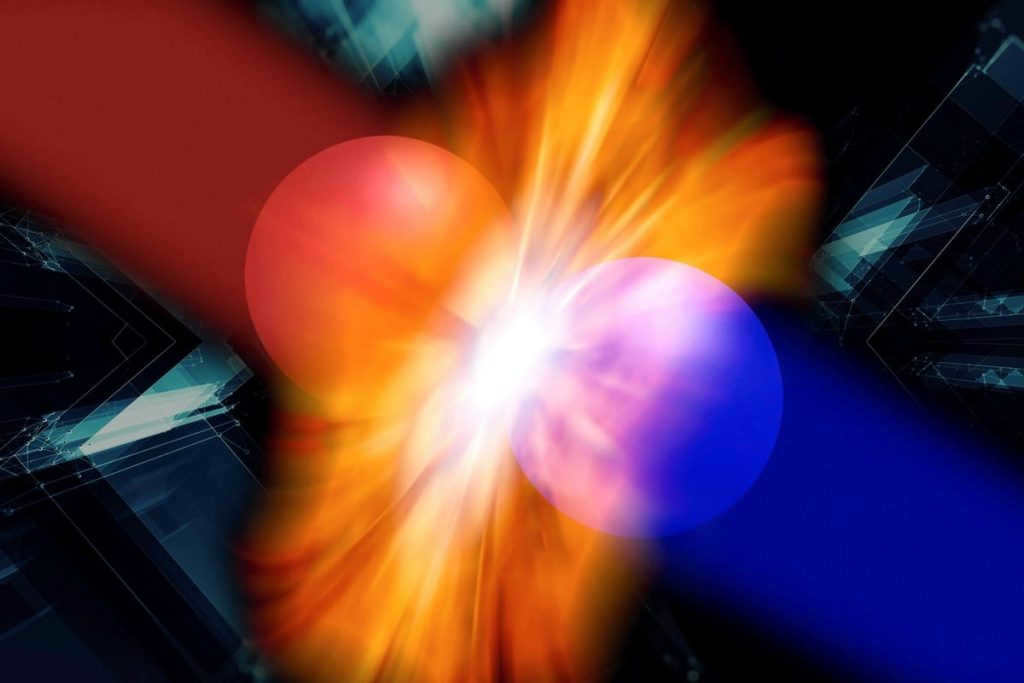
While it might seem like a concept straight out of a science fiction novel, the existence of antimatter is a scientific reality. Antimatter emerged alongside matter following the occurrence of the Big Bang. However, in the present-day universe, it is exceedingly rare and the scientific community remains uncertain as to why.
What enables antimatter particles to traverse the galaxy?
Within the vast expanse of the universe, antimatter is an elusive and unpredictable force: it obliterates upon contact with ordinary matter, resulting in a cosmic obstacle course of annihilation. Nevertheless, through a groundbreaking experiment at particle collider facilities, scientists have recently discovered that certain antimatter particles can endure interstellar travel without succumbing to destruction.
These particles are believed to be generated through collisions between highly energized cosmic rays and atoms that are essentially “drifting” through space, as well as through the collisions of dark matter particles (which were previously explained in detail by Hitech).
If these minuscule pieces have the ability to endure such extraordinary voyages, they will aid researchers in comprehending the essence of this enigmatic substance that comprises the majority of our galaxy – dark matter.
What was the procedure of the experiment?
By utilizing data obtained from the Large Hadron Collider, scientists have examined whether antinuclei created in outer space can successfully reach detectors located near Earth without disintegrating. To put this theory to the test, physicists carried out an experiment within a laboratory at CERN, Switzerland. The scientists attempted to measure something that seemed implausible: the repercussions of the annihilation of antigelium nuclei.
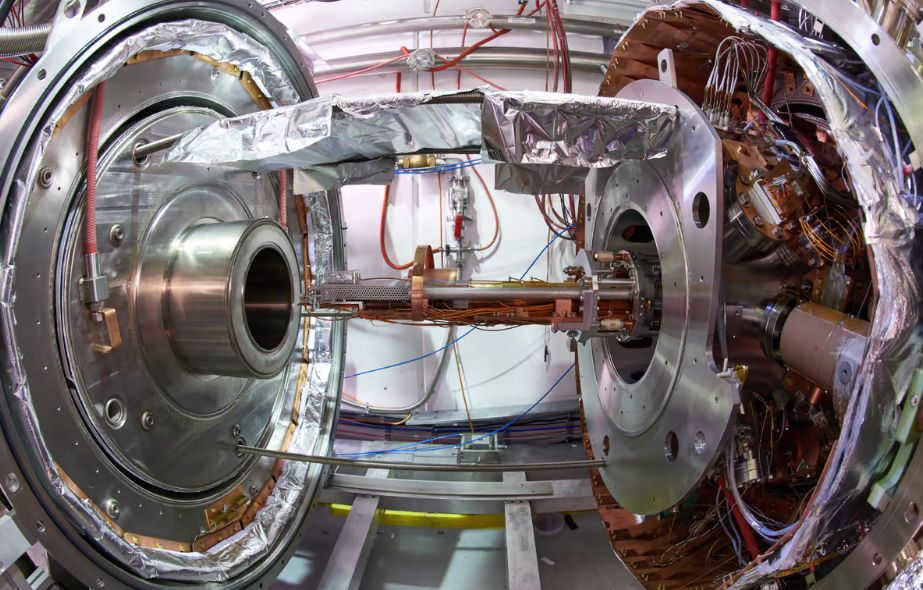
By utilizing the ALICE detector, the researchers performed a meticulous calculation of the collisions between high-energy protons and atoms that typically generate an equal number of helium and antigelium nuclei. Through estimation of the number of annihilations of antigyaders on various detector materials like steel and carbon, the scientists were able to precisely determine the intricacies of the interaction between these particles and regular matter.
The discoveries made in this study will contribute to resolving longstanding inquiries regarding the characteristics of antimatter and its significance in the cosmos.
What were the scientists able to determine?
The scientists were able to determine that the likelihood of antimatter particles becoming extinct is remarkably low based on computer modeling. They discovered that even when traveling vast distances through interstellar space, up to 50% of the antinuclear particles generated by dark matter would remain intact as they approached Earth.
In addition, physicists have observed that the antinuclear particles produced by cosmic rays possess higher levels of energy compared to those produced by dark matter. In fact, only antinuclei with high energy levels are able to reach Earth in significant quantities. Another research study demonstrated how conventional detectors can effectively detect dark matter with impressive signal-to-noise ratios if it originates from astrophysical sources.
Why it is important.
Physicists from all over the world have stated that understanding the enigmatic origin of dark matter is a crucial priority for contemporary science. The authors of the recent research also mentioned that delving deeper into the study of antinuclear formation could prove to be extremely valuable in gaining a better understanding and further refining theories regarding dark matter itself.
The groundbreaking nature of the new experiments has already been recognized as a significant contribution to answering one of the most critical questions in modern science: the existence of antimatter particles. Recently, the Alpha Magnetic Spectrometer, a detector aboard the International Space Station, has already detected potential signatures of antimatter. So, we are close to finding a clue.
For more information, click here:
Cover image: Jingchuan Yu, Beijing Planetarium
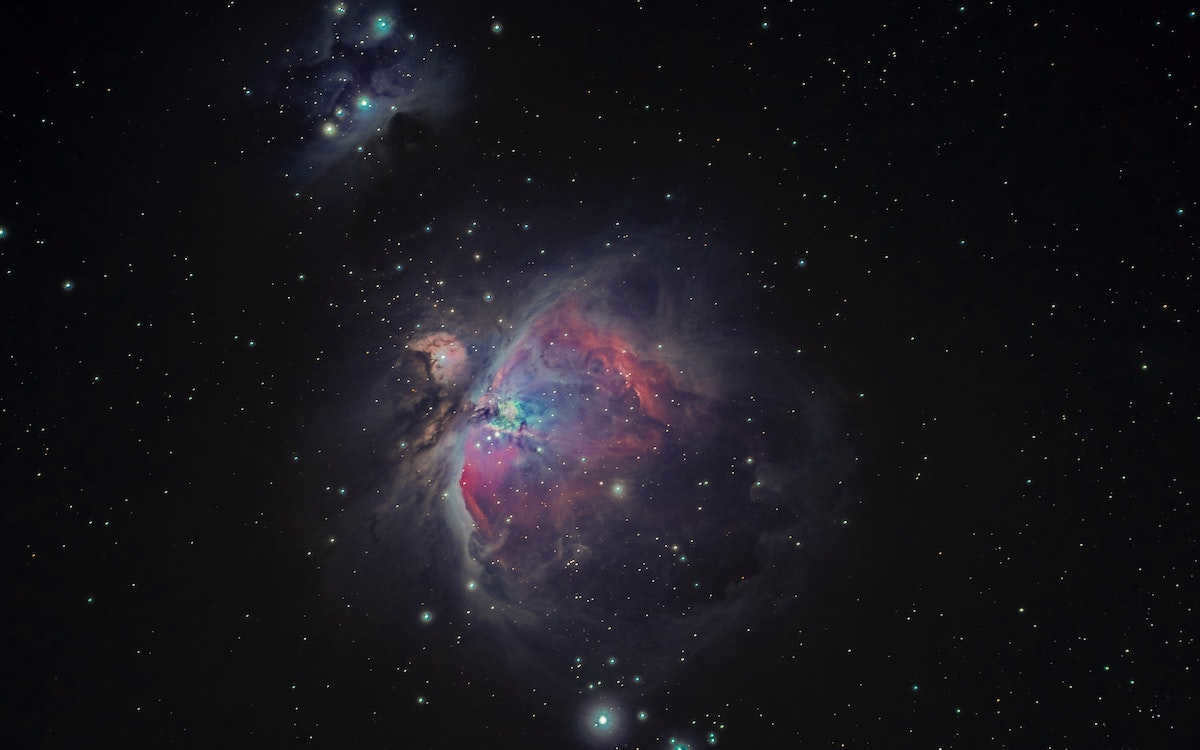
In the realm of particles, the building blocks of our world consist of three fundamental entities namely electrons, protons, and neutrons. However, intriguingly, each of these particles possesses an antiparticle counterpart that, when brought together, results in a tremendous release of energy. The whereabouts of these antiparticles, the cost of retrieving them, and their practical significance are subjects of immense interest.
What is antimatter
Antimatter, also known as antimatter, is a unique form of matter that is composed of antiparticles. Just like ordinary matter, antimatter is made up of atoms, which are comprised of protons and neutrons in the atomic nucleus, as well as electrons in the outer shell. However, in the case of antimatter, these particles are actually antiprotons, antineutrons, and positrons, which are the antielectrons.
Where can antimatter be found?
Antiparticles are created in the nuclei of active galaxies, just like they are in particle accelerators. However, they quickly annihilate upon contact with particles. On Earth, antimatter, or more specifically antiparticles, can be found in three different scenarios. Firstly, they are formed in the upper atmosphere as a result of cosmic rays, which have high energy on the scale of elementary particles. When these cosmic rays interact with terrestrial particles, similar processes occur to those in particle accelerators.
Secondly, antiparticles can be formed during lightning discharges. Lightning discharges can be seen as natural reactors. The gamma rays produced during a lightning discharge have enough energy to dislodge a neutron from atmospheric nitrogen, resulting in the formation of the unstable nitrogen isotope 13N.
The half-life of nitrogen-13 decaying to carbon-13 is slightly under 10 minutes, meaning that the most active period of positron emission occurs within a relatively short timeframe. This particular timeframe may be considered short by human standards, but it is relatively long when viewed from the perspective of elementary particles. Japanese scientists recently observed a series of low-energy gamma ray bursts during a lightning discharge, with the final burst lasting approximately one minute. This extended duration raised suspicions among the scientists, as it indicated the annihilation of electron-positron pairs.
Ultimately, antiparticles are generated within gas pedals, usually as a consequence of other experiments. At this point in the scientific realm, the detection of antiparticles in colliders does not elicit excitement from anyone. The enigmas lie not in the mere existence of antiparticles, but rather in the scarcity of their presence in the cosmos, considering that they are generated in equal measure to particles within gas pedals.
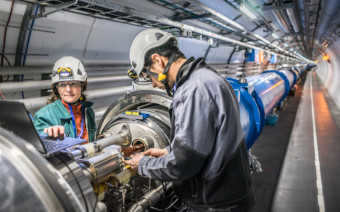
Antimatter vs Matter
In the early phases of the universe, it is believed that there was a disruption in the balance between particles and antiparticles. The ratio of particles to antiparticles was estimated to be 1 particle per 1 billion particle-antiparticle pairs. When particles and antiparticles came into contact, most of the antiparticles were annihilated, explaining the scarcity of antiparticles that we observe today.
Maybe the breaking of symmetry in the early universe is related to the distinct characteristics of short-lived particles such as K mesons and the varying properties of matter and antimatter caused by the presence of three generations of quarks. It could also be linked to charmed mesons, which are fleeting particles capable of transitioning between two states: particle and antiparticle. This discovery was made by Oxford scientists in June 2021.
Baryon asymmetry is a concept that pertains exclusively to the fields of cosmology and particle physics. If baryons and antibaryons possessed identical properties and there was no discernible distinction between matter and antimatter, then, as demonstrated by academician Andrei Sakharov in 1967, the entire Universe would have undergone a transformation into radiation – clearly, this scenario did not come to pass. However, it is conceivable that matter and antimatter were not uniformly distributed throughout the early Universe but rather dispersed in disparate directions – in our particular sector, matter predominates, while in other regions, it is plausible that antimatter stars form antigalaxies?
Theoretically, this scenario is feasible, albeit highly improbable, as the density of the early Universe was too immense for substantial clusters to simply disperse in various directions without first coming into contact with each other.
Nevertheless, there is an ongoing search for anti-stars. In order to detect them, the nuclei of antigelium must be recorded, as only antigelium can provide assurance that it was not formed due to the influence of cosmic rays – antiprotons and antideuterons (which consist of an antiproton and an antineutron, forming the nucleus of the heavy isotope of hydrogen – deuterium) cannot offer this guarantee. However, the formation of antigelium nuclei is extremely rare, so if they are detected, it indicates that they were produced as a result of thermonuclear reactions in anti-stellar environments.
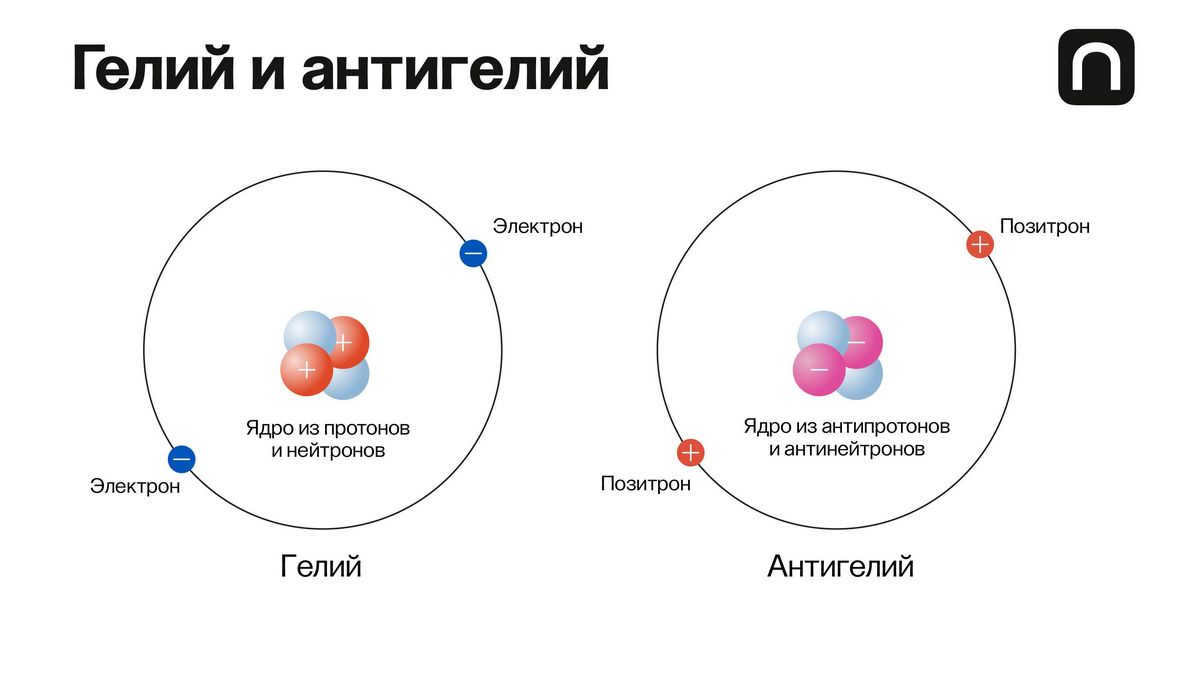
In 2021, a group of researchers published a study in which they compiled a list of 14 potential antistar candidates. These candidates were identified through an analysis of data gathered by the Fermi Space Telescope. The telescope’s data revealed the presence of antigelium nuclei.
Dmitry Kazakov, a Doctor of Physical and Mathematical Sciences from the Joint Institute for Nuclear Research in Dubna, commented on the study:
“The issue of the Universe’s asymmetry in terms of matter and antimatter is a significant one in the field of high-energy physics. However, a clear understanding of this phenomenon has yet to be achieved. It is believed to be related to the properties of elementary particle interactions and potentially involves the existence of new particles.”
When examining the range of cosmic rays, the detection of positrons and antiprotons is only possible because they are significantly smaller in comparison to the overall background and can be detected through the annihilation signal. Consequently, attempts are made to detect signals originating from dark matter, for instance. However, antiparticles are not extensively researched and do not attract much attention. It is well-known that all particles have corresponding antiparticles with identical properties. There is no enigma here, except for the question of how the Universe became biased towards particles.”

Antimatter versus dark matter
It is crucial to distinguish between antimatter and dark matter. Although both phenomena share a certain level of mystery and are associated with the term “matter,” they are distinct from one another.
Dark matter earned its name because of its lack of engagement in electromagnetic interactions, meaning it does not emit light. However, it also does not obstruct light like gas-dust nebulae do. Dark matter is detected through its gravitational influence on mass and its impact on the movement of stars within our galaxy and others. This means that stars do not orbit the galactic center as expected based on visible mass. In other words, either Newton’s laws do not hold true for large objects, or there exists an invisible mass that scientists have yet to detect.
The exploration of antimatter
Antimatter was first anticipated by Arthur Shuster, who coined the term in 1898. Following the revelation of the electron by Joseph Thomson the previous year, Shuster conjectured that the electron must have a corresponding particle. In his correspondences to the scientific journal Nature, he endeavored to persuade the scientific community of the validity of his hypothesis. However, lacking concrete evidence and relying solely on intuition and flawed logic, Shuster’s ideas were dismissed as frivolous, and he was disregarded as a mere eccentric.
The emergence of antimatter
In 1928, the renowned English theoretical physicist of Swiss descent, Paul Dirac, made a groundbreaking discovery by formulating an equation to describe the behavior of electrons. This significant achievement earned him the Nobel Prize in Physics in 1933, which he shared with Erwin Schrödinger under the official citation “For the discovery of new productive forms of atomic energy.” Dirac’s equation not only provided insights into the electron’s properties but also hinted at the existence of antimatter.
The equation, when solved, revealed the possibility of particles with negative energy and, consequently, negative mass. Although mathematically plausible, this concept presented numerous challenges in terms of aligning with established physical laws.
Therefore, there exists a particle possessing the mass of an electron, albeit with an opposite electric charge. This particular particle was uncovered in 1932 by Carl David Anderson, an experimental physicist from the United States, which led to his receipt of the Nobel Prize in Physics in 1936.
The Process of Attaining Antimatter
It is not uncommon to hear antimatter referred to as “the most valuable substance in existence.” Supposedly, a single gram of antimatter is valued at $63.5 trillion. However, this statement is somewhat misleading. The reality is that antimatter is not bought or sold, and the quantity produced in experiments is only a minuscule fraction of a gram. Additionally, it is crucial to recognize that generating antiparticles and constructing antimatter atoms from them are two distinct challenges, with the latter being significantly more complicated than the former.
The excitement surrounding antimatter and its incredible energetic properties is likely due to Dan Brown’s novel “Angels and Demons,” which revolves around the abduction of a container holding antimatter. In the book, there is a potential explosion that could destroy the Vatican, leading to thrilling adventures to prevent this catastrophic event. However, it is important to distinguish between fiction and reality. The amount of antimatter produced in experiments is extremely small, not even reaching micrograms or nanograms, but rather at the atomic level. If anti-atoms can be formed from antiparticles, they are trapped using magnetic fields because they cannot interact with regular atoms. Experiments are conducted to study their properties, but the lifespan of anti-atoms is very short in comparison to everyday standards, lasting only seconds or, in rare cases, minutes.
So how did the precise price of antimatter come about? If it isn’t purely fictional, the price can be determined using the following method, which was likely employed. Scientists receive funding for very specific purposes, such as studying the properties of antihydrogen. The head of the research reports to the organization that provided the funding on the results obtained, which can be both positive and negative. Therefore, the synthesis of antihydrogen was not a spur-of-the-moment decision or an accident – it was the objective of the scientific group’s work.
Now, if we know the amount of the grant (which is not a secret) and the number of antihydrogen atoms produced from the experiment, we can calculate the cost of 1 gram of antihydrogen by knowing the mass of a hydrogen molecule (consisting of two atoms).
Understanding Antiparticles
Antihydrogen is not the sole example of antimatter that has been successfully acquired through experimentation. Other examples include antideuterium, which is an isotope of antihydrogen with an antineutron nucleus, as well as antitritium, which possesses two antineutrons. Additionally, antigelium-3 and antigelium-4 have also been observed.
Given that the price of a commodity is determined by the intersection of supply and demand, it is not applicable to discuss the price of antimatter. Antimatter is produced solely for scientific research purposes and does not have a market driven by supply and demand.
Utilization of antimatter
Antimatter in the field of medicine
Positron emission tomography or PET, a technique for analyzing the internal organs of humans or animals, relies on the emission of positrons, which are antiparticle electrons.
When conducting PET scans, it is preferable to utilize the radioactive isotope Fluorine-18 due to its relatively long half-life of 109.8 minutes. This means that it takes a significant amount of time for half of the Fluorine-18 atoms to decay into oxygen. Additionally, Fluorine-18 has a relatively low radiation dose burden on the patient, as the gamma rays produced during annihilation are not harmful.
For instance, when diagnosing cancer, a small quantity of glucose (known as fluorodeoxyglucose or FDG) containing a radionuclide is administered to the patient. Since cancer cells divide rapidly and require energy to do so, they absorb glucose in large amounts. The high concentration of glucose in cancer cells results in an increased emission of positrons within the malignant tumor. This enables visualization of the tumor using PET scanners.
Positron emission tomography (PET) is not without risks – a standard PET scan using FDG exposes patients to a radiation dose of 14 millisieverts (mSv). To put this in perspective, this is equivalent to the total radiation exposure one would receive from over 4500 hours of flying in a passenger airliner at a standard altitude, or approximately 70% of the safe annual radiation dose according to Russian standards (or 28% of the safe annual dose according to IAEA standards). However, it is important to note that positron-electron pair annihilation, which is the process used in PET scans, cannot cause harm or be lethal.
Antimatter for Energy: Challenges and Opportunities
The idea of harnessing the power of antimatter for military applications or as a source of energy may seem appealing at first glance. However, a closer look reveals several significant hurdles that need to be overcome. The primary challenge lies in the production of antimatter, which is not only incredibly expensive but also has a limited lifespan. To effectively utilize antimatter for space travel or to provide electricity to cities, it must not only be generated but also stored and transported to the desired location. Unfortunately, there is currently no ongoing research on the industrial-scale production, storage, and utilization of antimatter.
Dmitry Kazakov:
“Antiatoms possess the same characteristics as atoms, including weight, radiation spectrum, and chemical properties. Obtaining antiparticles is not a complex task; we can generate antielectrons or antiprotons through gas pedals, produce antiparticles at colliders, or even receive them from outer space. However, antiparticles are significantly smaller than regular particles and undergo annihilation upon contact with ordinary particles. Forming bound states in the form of anti-atoms is challenging, as it requires the simultaneous creation of antiprotons, antineutrons, and antielectrons. While CERN has managed to produce a small number of antigelium atoms, it is far from the quantities depicted in Dan Brown’s novel. The creation and preservation of antimatter is a difficult feat, making it unrealistic to accumulate antimatter for use as an energy source or weapon.”

Antimatter is a concept often explored in science fiction. In the book and film Angels and Demons, Professor Langdon embarks on a mission to protect the Vatican from the destructive power of an antimatter bomb. The starship Enterprise from the Star Trek series utilizes the incredible energy generated by matter-antimatter annihilation to achieve faster-than-light travel.
However, antimatter is not solely confined to the realm of fiction. In reality, antimatter particles are essentially identical to their matter counterparts, with the exception of carrying the opposite charge and spin. When matter and antimatter come into contact, they instantaneously annihilate each other, releasing a tremendous amount of energy.
While the idea of antimatter bombs and antimatter-powered spaceships may be fictional, there are numerous intriguing facts about antimatter that can captivate the mind.
1- Antimatter’s expected annihilation with all matter in the universe following the Big Bang
Based on the current theory, the Big Bang should have produced matter and antimatter in equal quantities. When matter and antimatter come into contact, they eliminate each other, resulting in the release of pure energy. Thus, in theory, none of us should exist.
However, we do exist. And according to physicists, this is only possible because, for every billion pairs of matter and antimatter, there is an additional particle of matter. Physicists are determined to unravel the mystery behind this asymmetry.
2- Antimatter is closer to you than you think.
There are various sources of antimatter that are closer to us than we realize. For instance, small amounts of antimatter fall to Earth on a regular basis in the form of cosmic rays, which are energetic particles from space. These antimatter particles enter our atmosphere in different quantities, ranging from less than one particle per square meter to over 100 per square meter. Additionally, scientists have observed evidence of antimatter in the atmosphere above thunderstorms.
However, there are even more accessible sources of antimatter. An interesting example is bananas, which produce antimatter by releasing a positron, which is essentially the equivalent of an electron, approximately every 75 minutes. This phenomenon occurs because bananas contain trace amounts of potassium-40, a naturally occurring isotope of potassium. When potassium-40 undergoes decay, it periodically emits a positron.
Our bodies also contain potassium-40, which means that you also emit positrons. When antimatter comes into contact with matter, it immediately annihilates, making these antimatter particles very short-lived.
3- Humans have only produced a small quantity of antimatter
The annihilation of antimatter with matter can release enormous amounts of energy. An explosion the size of a nuclear bomb can be generated by just one gram of antimatter. However, humans have only managed to produce a tiny amount of antimatter so far.
All the antiprotons generated at Fermilab’s Tevatron particle accelerator would only amount to 15 nanograms. Those produced at CERN would amount to about 1 nanogram. To date, DESY in Germany has produced approximately 2 nanograms of positrons.
If all the antimatter ever produced by humans were to annihilate simultaneously, the resulting energy would not even be sufficient to boil a cup of tea.
The issue lies in the efficiency and cost associated with the production and storage of antimatter. Generating 1 gram of antimatter requires an estimated 25 million billion billion kilowatt-hours of energy and costs well over a million billion dollars.
4. The existence of an antimatter trap
To study antimatter, it is crucial to prevent its annihilation with regular matter. Scientists have developed various methods to achieve this.
One such method is the use of Penning traps, which can trap charged antimatter particles like positrons and antiprotons. These traps can be likened to miniature gas pedals, as the particles spiral within them due to the magnetic and electric fields that prevent them from colliding with the trap walls.
However, neutral particles like antihydrogen are not susceptible to Penning traps. Due to their lack of charge, electric fields are unable to confine these particles. Instead, they are captured using Ioffe traps, which function by establishing a spatial region where the magnetic field intensifies in all directions. The particle becomes trapped in the region with the weakest magnetic field, similar to a ball rolling within a broad bowl, gradually approaching the bottom.
Furthermore, the Earth’s magnetic field can serve as a type of trap for antimatter. Radiation belts surrounding the Earth have been found to contain antiprotons.
Antimatter and matter particles possess identical mass but exhibit differences in characteristics such as electric charge and spin. According to the Standard Model, gravity should exert the same influence on both matter and antimatter; however, this hypothesis has yet to be confirmed. The AEGIS, ALPHA, and GBAR experiments are actively striving to investigate this phenomenon.
Observing the impact of gravity on antimatter is not as straightforward as observing an apple descending from a tree. In these experiments, it is necessary to confine or decelerate antimatter by cooling it to just above absolute zero. Additionally, due to gravity being the weakest among the fundamental forces, physicists must use neutral antimatter particles in these experiments to prevent the more potent electric force from causing any interference.
6. Particle Moderators: The Key to Studying Antimatter
We are all familiar with particle gas pedals, but did you know that there are also particle moderators? At CERN, one such machine, known as the Antiproton Moderator, plays a crucial role in studying the properties and behavior of antimatter.
In circular particle accelerators like the Large Hadron Collider, particles gain extra energy with each revolution. However, in the case of particle moderators, the opposite effect is achieved. Instead of accelerating particles, these moderators apply a reverse jolt that slows down the velocity of particles.
7. Neutrinos might possess self-antiparticle nature
Neutrinos, being extremely lightweight particles that have minimal interaction with matter, do not possess any charge. In contrast, matter particles and their antimatter counterparts carry opposite charges, making them easily distinguishable. However, scientists speculate that neutrinos might belong to a hypothetical group of particles known as Majorana particles, which are characterized by being their own antiparticles.
In order to investigate this hypothesis, researchers have initiated projects like the Majorana Demonstrator and EXO-200. These projects aim to identify whether neutrinos exhibit a unique phenomenon called neutrino-free double beta decay. This decay occurs when certain radioactive nuclei simultaneously release two electrons and two neutrinos. If neutrinos are indeed their own antiparticles, they would annihilate each other during the double decay process, resulting in the observation of only electrons by scientists.
The detection of Majorana neutrinos could potentially provide an explanation for the observed disparity between antimatter and matter. Scientists propose that Majorana neutrinos may exist in two forms, either with a substantial mass or a negligible mass. The currently observed neutrinos are the light ones that continue to exist in the present, whereas the heavy neutrinos would have only been present immediately following the occurrence of the Big Bang. It is postulated that these heavy Majorana neutrinos would have decayed in an asymmetric manner, ultimately leading to a slight surplus of matter.
PET (positron emission tomography) utilizes positrons to generate high-resolution imagery of the human body. The radioactive isotopes that emit positrons (similar to those present in bananas) bind to naturally occurring chemicals, like glucose, that are utilized by the body. These isotopes are administered into the bloodstream where they naturally decay, releasing positrons that subsequently interact with electrons in the body and undergo annihilation. This annihilation process results in the emission of gamma rays, which are then employed for the purpose of imaging.
Researchers at CERN’s ACE project are investigating the potential use of antimatter in the treatment of cancer. Medical professionals have already found that they can focus particle beams on tumors, allowing them to release their energy only after passing through healthy tissue. By utilizing antiprotons, it may be possible to enhance this energy release. While this method has shown success in hamsters, further research is needed to determine its efficacy in human cells.
9. The existence of hidden antimatter in space may yet be discovered
In an effort to address the disparity between antimatter and matter, scientists are currently engaged in a search for traces of antimatter remaining from the Big Bang.
The Alpha Magnetic Spectrometer, a particle detector located on the International Space Station, is specifically designed to detect these elusive particles. By manipulating magnetic fields, the AMS is able to alter the paths of cosmic particles, effectively separating matter and antimatter. Sophisticated detectors then analyze and identify the particles as they traverse through the AMS.
Positrons and antiprotons are commonly generated through collisions of cosmic rays. However, the probability of generating an antigelium atom is remarkably low due to the immense energy it demands. Therefore, the detection of a solitary antigelium nucleus would serve as compelling evidence for the presence of substantial quantities of antimatter elsewhere in the cosmos.
Just a few particles of antimatter can generate a tremendous amount of energy, which makes it a popular choice for fuel in futuristic vehicles depicted in science fiction.
The possibility of using antimatter for rocket propulsion exists in theory, but the main obstacle lies in the ability to harvest a sufficient amount of antimatter.
At present, there is no technology capable of mass-producing or harvesting antimatter on the scale required for this purpose. Nevertheless, certain researchers have conducted simulation studies on antimatter engines and storage. If a method for producing or harvesting large quantities of antimatter can be developed, this research could pave the way for the realization of antimatter-powered interstellar travel.

Antimatter, which is the contrary of the familiar matter, possesses an enigmatic nature. Moreover, when antimatter comes into proximity with regular matter, a process of annihilation takes place due to their interaction.
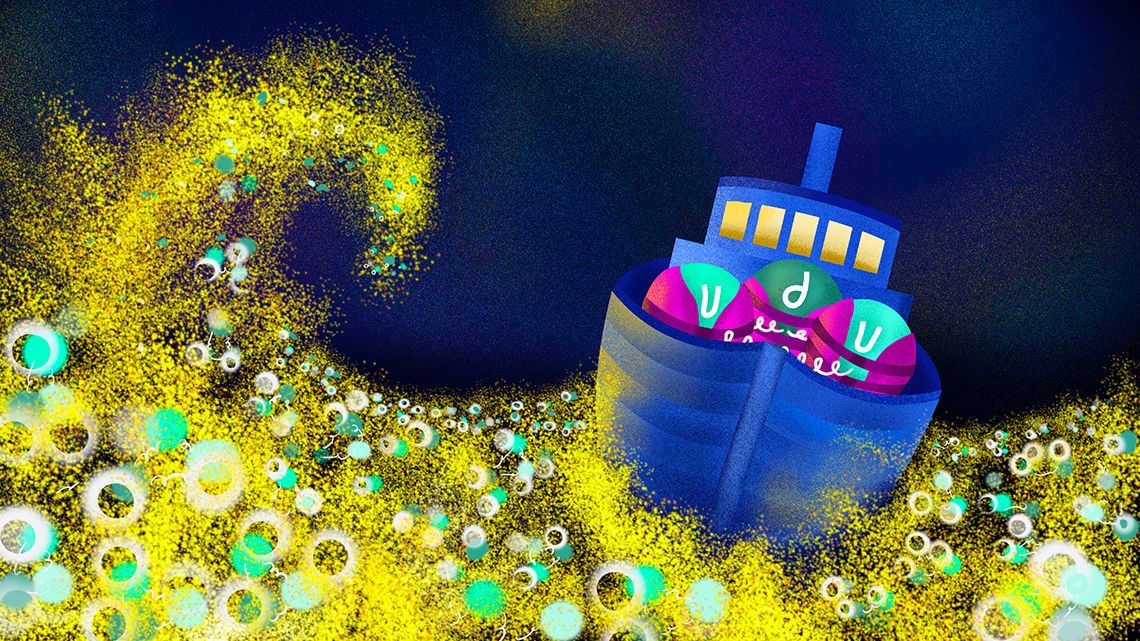
However, there are even more fascinating facts associated with it – and here are four of the most intriguing ones.
Antimatter exists in all atoms
The proton, neutron, and electron are likely the first three subatomic particles you learned about. These particles make up the atoms that compose our bodies and the world around us.
Out of these particles, only the electron is considered elementary, which means it is not composed of smaller components. On the other hand, protons and neutrons are composed of elementary particles known as quarks and gluons.
According to Beatriz Gato-Rivera, a scientist at Spain’s National Research Council and author of a book on antimatter, protons and neutrons can be described as particles made up of only three quarks. This is because in the chaotic world of particle creation and annihilation, only three quarks remain unmatched by their antimatter counterparts. Thus, antiprotons, which are the “antimatter” versions of protons, contain three antiquarks that are not paired with their counterparts.
Antimatter is present everywhere, including within the atoms of your body and all the objects around you.
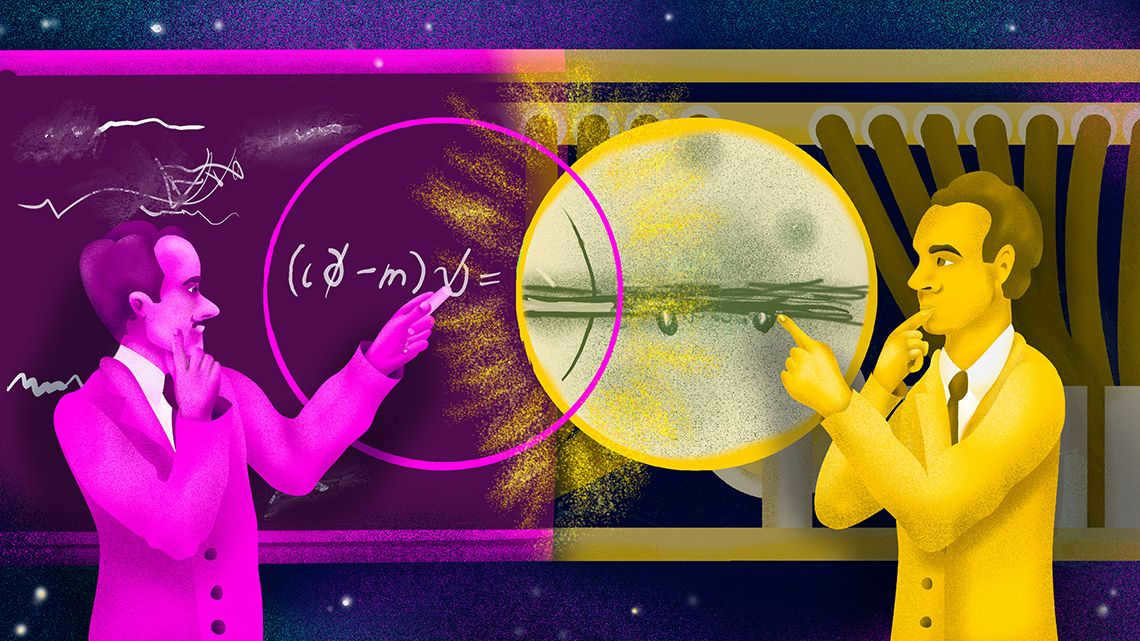
The prediction of antimatter came about through mathematical calculations
In 1928, physicist Paul Dirac from Britain encountered a puzzle. In order to explain the behavior of electrons, he developed a theory that combined Einstein’s special relativity with quantum mechanics. However, to make his mathematical equations accurate, he required a particle that, during that time, was not yet discovered. This new particle had to possess the same mass as an electron, but with the opposite charge.
After three years, he finally proposed the existence of such a particle and named it an “antielectron”.
In the year mentioned above, Carl Anderson, a physicist from the California Institute of Technology, captured images of peculiar particles while examining cosmic rays that were passing through a particle detector known as the “cloud chamber.” Anderson’s research in 1932 validated Dirac’s predictions as he discovered that the traces were indeed produced when cosmic rays interacted with the Earth’s atmosphere. He named these particles “positrons.” This groundbreaking discovery marked the first ever confirmed observation of antimatter.
Currently, researchers are actively searching for additional particles, such as axions, supersymmetric particles, and particles of dark matter, that have the potential to provide explanations for numerous unresolved enigmas in the fields of particle physics and cosmology.
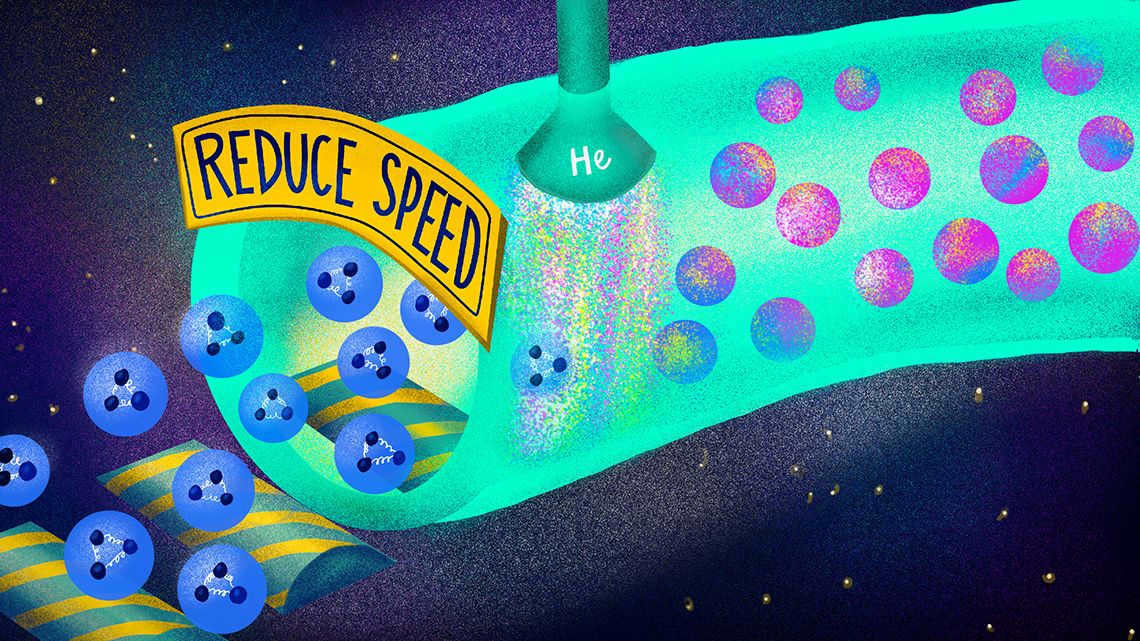
Scientists Have the Ability to Produce Hybrid Atoms Containing Antimatter
Through the process of slowing down antiprotons in a particle moderator and then combining them with cryogenic helium, scientists are able to create a unique type of atom known as “antiproton helium.”
These types of atoms are often referred to as “exotic” due to the fact that one of the constituent particles is replaced with another particle that has the same charge. In certain cases, this new particle is actually a form of antimatter. For instance, in antiproton helium, the electron of the helium atom is substituted with an antiproton. Other examples include muonium (which consists of an antimuon and an electron) and positronium (which consists of an electron and a positron).
Exotic atoms play a crucial role in examining the interactions that occur between matter and antimatter on a microscopic scale. By observing the short-scale interactions between particles and antiparticles within atoms, researchers are able to investigate phenomena that would otherwise be inaccessible.
“These short-scale interactions serve as a valuable tool in the pursuit of uncovering new insights into physics,” explains Anna Soter, a particle physicist at ETH Zurich.
Scientists utilize exotic atoms to search for potential evidence of a “fifth interaction” between an antiproton and an electron. Additionally, exotic atoms are employed to conduct highly precise measurements of particle properties, enabling scientists to test the symmetries outlined in the Standard Model. For instance, the model predicts that particles and their antiparticles should possess identical mass and charge values, albeit with opposite signs.
“Currently, researchers have been able to use laser spectroscopy to study the metastable antiproton helium atom, which is the largest exotic atom containing antimatter,” says Soter. – However, there are also simpler systems like muonium and positronium that are worth studying. These atoms consist only of elementary particles without any strong interactions.”
+
Moreover, scientists have the ability to create anti-atoms in addition to hybrid particles. One example is the production of antihydrogen by combining antiprotons and positrons at CERN.

Scientists have made a groundbreaking discovery of an abundance of antimatter in our galaxy that currently exceeds their understanding
During the 1970s, the INTEGRAL mission by the European Space Agency made a remarkable detection of gamma rays originating from the heart of the Milky Way. The intensity and dispersion of this signal suggested that an astonishing 9 trillion kilograms of positrons (equivalent to 10,43 positrons) were annihiliating within the core of our galaxy every second – a quantity that surpassed scientists’ initial expectations.
The origins of these positrons remain a mystery, leaving scientists with several potential sources to consider. These include the presence of a supermassive black hole at the center of our galaxy, other nearby massive black holes, rapidly spinning neutron stars known as pulsars, and even the annihilation of particles of dark matter.
Multiple experiments have been developed to identify the origin of gamma rays in the center of our Milky Way galaxy. One such example is the Compton Spectrometer and Imager (COSI), a gamma-ray telescope that aims to capture images of the galactic core in order to locate the source of positrons. Additional projects, like the proposed All Planetary Medium Energy Gamma-ray Observatory (AMEGO), are also expected to contribute valuable insights into this enigma.
In more recent times, scientists have made another intriguing discovery related to positrons, this time at significantly higher energy levels. The PAMELA cosmic ray detector, which was deployed on a Russian satellite in 2008, revealed an unexpectedly abundant presence of antimatter particles passing by Earth. These findings have been corroborated by other experiments such as AMS-02, which has been operational on the International Space Station since 2011, lending further credibility to the observations made by the PAMELA collaboration.

